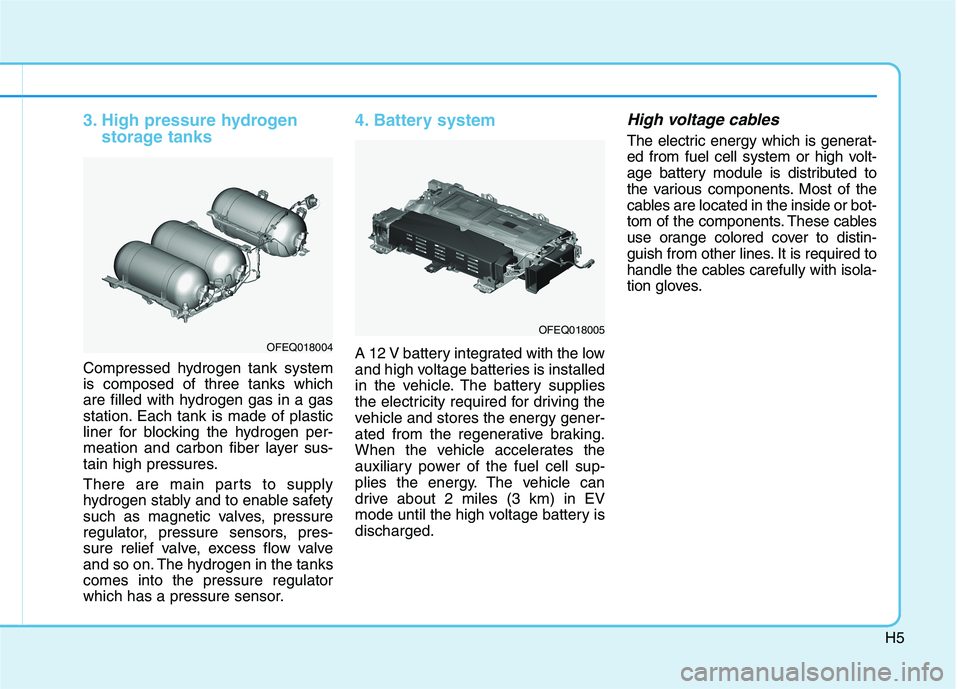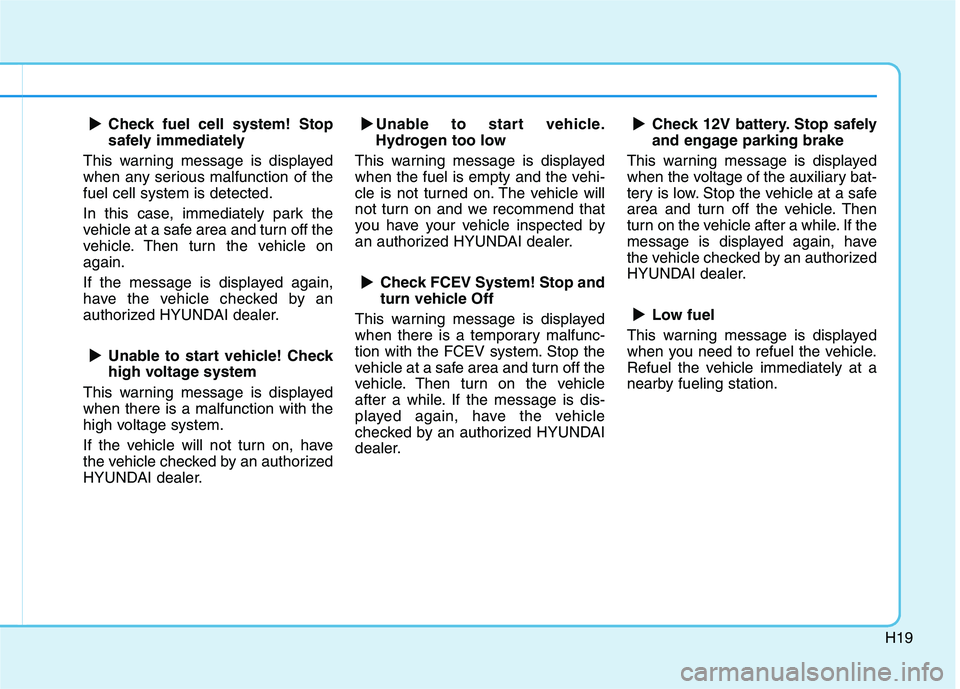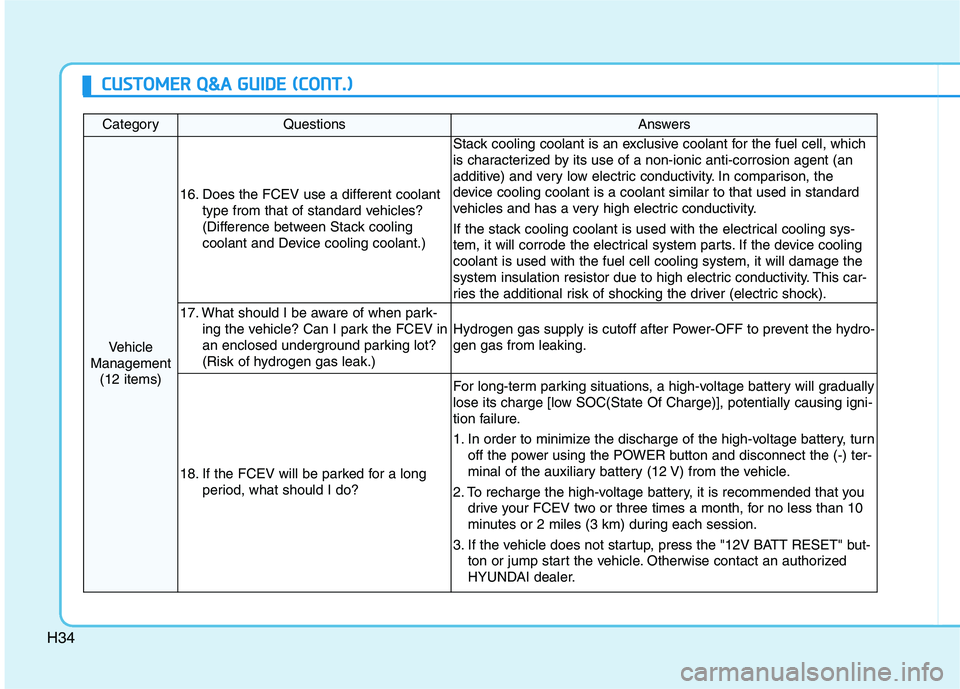Page 510 of 561

H5
3. High pressure hydrogen
storage tanks
Compressed hydrogen tank system
is composed of three tanks which
are filled with hydrogen gas in a gas
station. Each tank is made of plastic
liner for blocking the hydrogen per-
meation and carbon fiber layer sus-
tain high pressures.
There are main parts to supply
hydrogen stably and to enable safety
such as magnetic valves, pressure
regulator, pressure sensors, pres-
sure relief valve, excess flow valve
and so on. The hydrogen in the tanks
comes into the pressure regulator
which has a pressure sensor.
4. Battery system
A 12 V battery integrated with the low
and high voltage batteries is installed
in the vehicle. The battery supplies
the electricity required for driving the
vehicle and stores the energy gener-
ated from the regenerative braking.
When the vehicle accelerates the
auxiliary power of the fuel cell sup-
plies the energy. The vehicle can
drive about 2 miles (3 km) in EV
mode until the high voltage battery is
discharged.
High voltage cables
The electric energy which is generat-
ed from fuel cell system or high volt-
age battery module is distributed to
the various components. Most of the
cables are located in the inside or bot-
tom of the components. These cables
use orange colored cover to distin-
guish from other lines. It is required to
handle the cables carefully with isola-
tion gloves.
OFEQ018004
OFEQ018005
Page 524 of 561

H19
Check fuel cell system! Stop
safely immediately
This warning message is displayed
when any serious malfunction of the
fuel cell system is detected.
In this case, immediately park the
vehicle at a safe area and turn off the
vehicle. Then turn the vehicle on
again.
If the message is displayed again,
have the vehicle checked by an
authorized HYUNDAI dealer.
Unable to start vehicle! Check
high voltage system
This warning message is displayed
when there is a malfunction with the
high voltage system.
If the vehicle will not turn on, have
the vehicle checked by an authorized
HYUNDAI dealer.Unable to start vehicle.
Hydrogen too low
This warning message is displayed
when the fuel is empty and the vehi-
cle is not turned on. The vehicle will
not turn on and we recommend that
you have your vehicle inspected by
an authorized HYUNDAI dealer.
Check FCEV System! Stop and
turn vehicle Off
This warning message is displayed
when there is a temporary malfunc-
tion with the FCEV system. Stop the
vehicle at a safe area and turn off the
vehicle. Then turn on the vehicle
after a while. If the message is dis-
played again, have the vehicle
checked by an authorized HYUNDAI
dealer.Check 12V battery. Stop safely
and engage parking brake
This warning message is displayed
when the voltage of the auxiliary bat-
tery is low. Stop the vehicle at a safe
area and turn off the vehicle. Then
turn on the vehicle after a while. If the
message is displayed again, have
the vehicle checked by an authorized
HYUNDAI dealer.
Low fuel
This warning message is displayed
when you need to refuel the vehicle.
Refuel the vehicle immediately at a
nearby fueling station.
▲ ▲ ▲
▲
▲ ▲ ▲
▲
▲ ▲ ▲
▲
Page 539 of 561

H34
CategoryQuestionsAnswers
Vehicle
Management
(12 items)
16. Does the FCEV use a different coolant
type from that of standard vehicles?
(Difference between Stack cooling
coolant and Device cooling coolant.)
Stack cooling coolant is an exclusive coolant for the fuel cell, which
is characterized by its use of a non-ionic anti-corrosion agent (an
additive) and very low electric conductivity. In comparison, the
device cooling coolant is a coolant similar to that used in standard
vehicles and has a very high electric conductivity.
If the stack cooling coolant is used with the electrical cooling sys-
tem, it will corrode the electrical system parts. If the device cooling
coolant is used with the fuel cell cooling system, it will damage the
system insulation resistor due to high electric conductivity. This car-
ries the additional risk of shocking the driver (electric shock).
17. What should I be aware of when park-
ing the vehicle? Can I park the FCEV in
an enclosed underground parking lot?
(Risk of hydrogen gas leak.)
Hydrogen gas supply is cutoff after Power-OFF to prevent the hydro-
gen gas from leaking.
18. If the FCEV will be parked for a long
period, what should I do?
For long-term parking situations, a high-voltage battery will gradually
lose its charge [low SOC(State Of Charge)], potentially causing igni-
tion failure.
1. In order to minimize the discharge of the high-voltage battery, turn
off the power using the POWER button and disconnect the (-) ter-
minal of the auxiliary battery (12 V) from the vehicle.
2. To recharge the high-voltage battery, it is recommended that you
drive your FCEV two or three times a month, for no less than 10
minutes or 2 miles (3 km) during each session.
3. If the vehicle does not startup, press the "12V BATT RESET" but-
ton or jump start the vehicle. Otherwise contact an authorized
HYUNDAI dealer.
C CU
US
ST
TO
OM
ME
ER
R
Q
Q&
&A
A
G
GU
UI
ID
DE
E
(
(C
CO
ON
NT
T.
.)
)